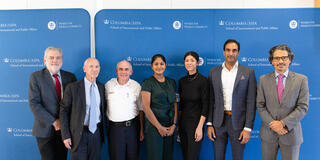Innovating City Government: NYC and COVID-19

SIPA hosted guests from the private, public, and academic sectors at the October 4 launch of the short film and case study Smarter New York City: How City Agencies Innovate in a Time of Crisis.
The film and study were produced by the Picker Center Digital Education Group and SIPA’s MPA in Development Practice. The event was moderated by Picker Center director Bill Eimicke and MPA-DP assistant director André Corrêa d’Almeida, with welcoming remarks from MPA-DP director Glenn Denning.
The panel focused on innovation in the public sector and how crises, such as COVID-19, can reveal city agencies’ abilities to innovate. As d’Almeida put it in his opening remarks: “Innovation happens all the time, but people always think of it as a private sector endeavor…. The way New York City responded to the COVID crisis shows that government is also a hub of innovation.”
The Smarter New York City case included profiles of the New York City Fire Department's Emergency Medical Services unit, the Department of Transportation, the Department of Education, the Department of Health and Mental Hygiene, and NYC’s Economic Development Corporation.
The case applied many principles laid out in d’Almeida’s 2018 book Smarter New York City: How City Agencies Innovate — including the theoretical framework of “innovation drivers” such as leadership, organizational culture, networks and interagency collaboration, institutional environment, data, technology, and results — that push development in the public sphere.
“The COVID crisis was the perfect example of how these innovation drivers work in practice. It made the internal dynamics of an innovation process much more salient,” d’Almeida stated. COVID-19, he said, “forced interagency collaboration to an unprecedented level in New York City.”
In addition to being part of SIPA’s ongoing digital Public Policy Case Collection, the project also built upon the Picker Center’s long history of collaboration with the New York City government, including its partnerships with FDNY-EMS through the Fire Officers Management Institute. This eight-week, intensive, in-residence program trains FDNY-EMS senior officers in management practices. The Picker Center will continue this collaborative tradition in 2023 with the upcoming Police Management Institute, a joint initiative with the NYPD.
Panelists included Jay Varma, a professor of public health at Weill Cornell Medicine who previously served as a senior adviser for public health under Mayor de Blasio; Judy Chang, director of special projects at the Department of Transportation; Cordell Schachter, former CTO at the Department of Transportation; Jonathan Pistilli, assistant chief of FDNY-EMS; and Priya Ananthanathan, vice president of funding agreements for the NYC Economic Development Corporation.
Watch the complete SHORT FILM | Watch a preview below:
Highlights
| “The single most important thing for a city government to do in an epidemic is to make sure that you can prevent as much illness and death as possible by marshaling all of the resources at your disposal. That includes both the resources of the government, but also of civil society and other organizations.” – Jay Varma |
|
“We had to mobilize (NYC Department of Transportation’s COVID-19 response) quickly because we were getting a lot of pressure, but also we understood that we were all going through the same thing together. I think that's one of the little silver linings to COVID-19: we were all really in it together for a moment there. So just as regular human beings, we were extremely sympathetic to this need to innovate and wanted to be helpful in any way. It takes a lot to set up a program this advanced quickly, but if we do it right, the average New Yorker has no idea what goes into it. It just works.” |
|
“Collaboration isn’t some corporate buzzword… Collaboration is selfish! If city agencies don’t collaborate, we all fail. It’s a necessity.” |
|
“The pandemic offered a unique opportunity to study in detail how innovation happens in city agencies even without being in a crisis mode. That's why it's so important that we understand how cities operate. It's almost like the crisis had amplified how city agencies operate and how they could be working in an idealized administrative process with less red tape and a stronger sense of urgency and collaboration. I would argue that what the COVID crisis brought was not really new ways of the city working, but made the day-to-day functionings more salient.” |
|
“The power in most societies is centralized in the national government, and then the regional or state government has the second most power, and the city government is a subset of the states. Yet when something unprecedented happens like a pandemic, the response is the city. They're the ones who are there on the ground. So it's the city government who's on the line for every major crisis. That’s why I was drawn to work in city government– I wanted to help people directly. That's what city government does.” |